“What's Art?” by Akitsune Tagami
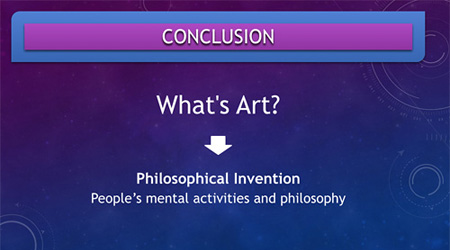
The art is invented from people's mental activities and philosophy. I concluded the idea for the what-isart question like this. Since I have been working as a patent engineer, I feel the importance of the management of intellectual property. In my work, I help to acquire a patent when an engineer develops a new technology; I always think what the most important concept is with the technology.
From these experiences with some bumps and detours, I finally found the answer to what-is-art.
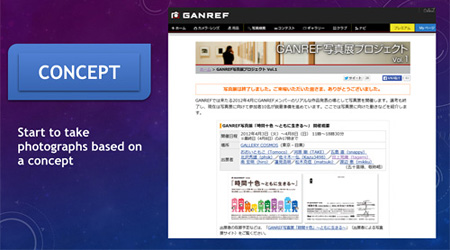
I joined the GANREF photo exhibition in April 2012. Mr. Yoshida, my adviser, said taking photographs based on a concept was very important. At first I didn't understand what he meant. But the harder I tried to think of the concept, the better my photos became. But my idea still wasn't enough, I started to be frustrated and wanted to know more what the concept of art really meant.
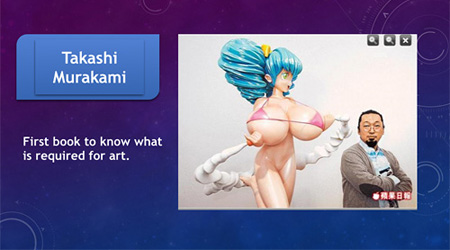
First, I read books by Takashi Murakami, who is Japanese contemporary artist, to know what is required for art.
Unfortunately, it was hard to sympathize with Murakami's artworks. Besides I couldn't understand why his works could be called 'art'.
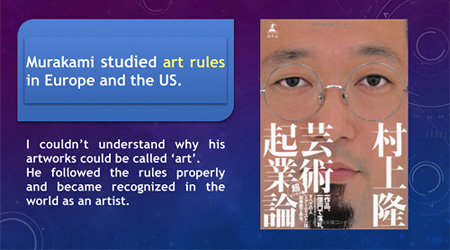
Murakami said in his books that he studied art rules in Europe and the US and it was very important to follow the rules properly. That's why he became recognized in the world as an artist. I still couldn't understand his works, but at least I learned that nothing would be conveyed if I don't follow the rules.
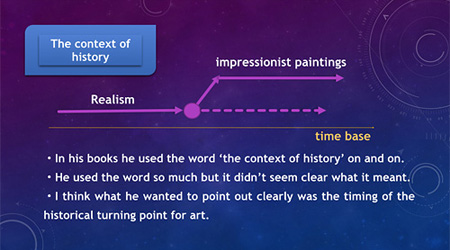
Murakami also said art has a healing power, for which I had sympathy. He said what was most important for art is a historical back ground as well.
He called it 'the context of history.' In his books he used the word on and on. Realism was mainstream once but gradually art moved into the era of impressionist paintings. It was watershed of the history of art. I think what Murakami wanted to point out clearly was the timing of the historical turning point for art.
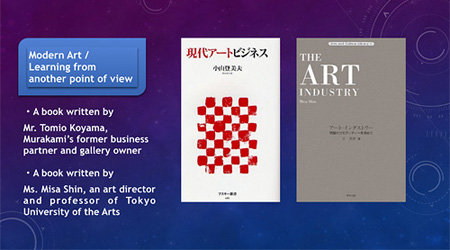
I kept on studying about what art was. I read two other artists' books. One was written by Mr. Tomio Koyama who was Murakami's former business partner and gallery owner, and the other one was written by Ms. Misa Shin who was an art director and professor of Tokyo University of the Arts.
From Shin's book, I learned there was a big movement for changing the art world at some point in 20th century; reviewers have defined the value of the arts. They have led the world in arts.
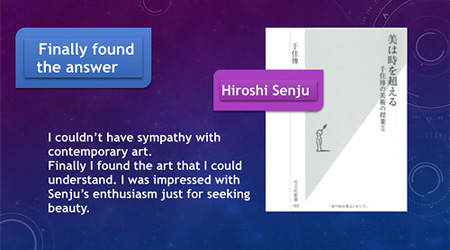
Talking about the art works, I never understood Makoto Kaida, who is well known as a contemporary Japanese artist.
It was also hard to understand Damien Hirst, who is famous for his artwork as dead cow preserved in formaldehyde.
Then, I read a book 'The beauty transcends time' written by Hiroshi Senju. Senju is one of Japanese-style painters and respected worldwide. I was impressed with Senju's enthusiasm just for seeking beauty.
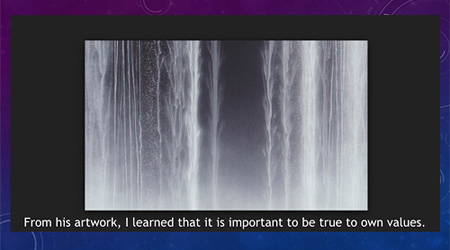
When I saw Senju's painting 'water fall', I thought that finally I found an artwork that I could understand.
In fact Senju said he didn't understand why the dead cow preserved in formaldehyde could be called art. Besides he thought artists should work harder to pursue an essential quality of art. From his artwork, I learned that it is important to be true to own values.
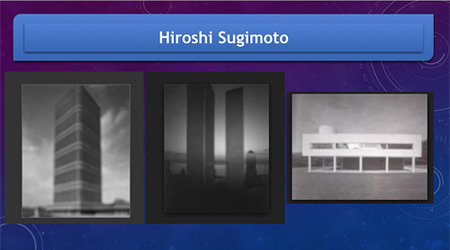
Meanwhile I was shocked with photographs taken by Mr. Hiroshi Sugimoto, a Japanese photographer. He took buildings out-of-focus. This is what he said in his statement of this work; 'In early 20th century the modernism developed and because of it, artists started to create things in their own style. I wanted to know when it started, I chose buildings as objects of my photographs. When I took the photo, I focus on double infinity. It was interesting that massive architecture is left even in fuzzy picture.
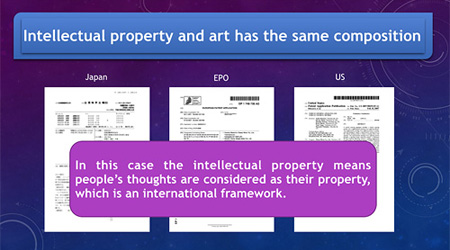
I was very surprised with his new perspective as a photographer. Even though I knew the view, nothing inspired me. Therefore, from the viewpoint as a patent engineer, I formed a hypothesis; Intellectual property and art has the same composition. In this case the intellectual property means people's thoughts are considered as their property, which is an international framework.
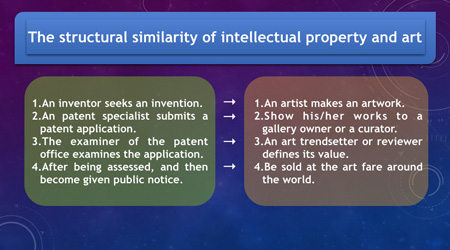
Let me show you the structural similarity of intellectual property and art below.
- Step toward the protection of intellectual property.
- An inventor seeks an invention.
- An patent specialist submits a patent application.
- The examiner of the patent office examines the application.
- After being assessed, and then become given public notice.
- Step toward the artwork
- An artist makes an artwork.
- Show his/her works to a gallery owner or a curator.
- An art trendsetter or reviewer defines its value.
- Be sold at the art fare around the world.
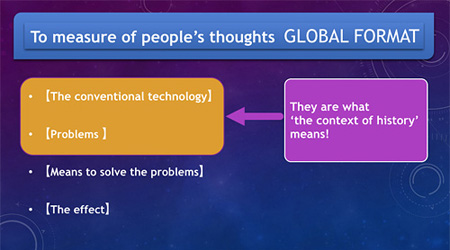
There are four compositions to measure of people's thoughts.
- The conventional technology
- Problems to be solved.
- Invention solves the problems.
- See the invention's effect.
Now I realized what 'the context of history' means which was mentioned by Mr. Hiroshi Murakami. It is the conventional technology and the problem.
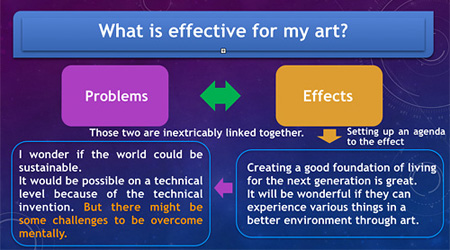
Then another question has come up; What is effective for my art? I don't take photographs for earning a lot of money and getting rich. I do this because I want to create a good foundation of living for my children. I will be happy when they grow up, they can experience various things in a better environment through art. So I setup an agenda to the effect.
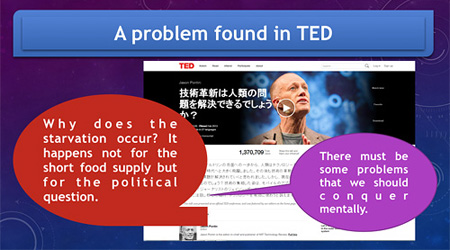
I wonder if the world could be sustainable. I think it would be possible on a technical level because of the technical invention. But there might be some challenges to be overcome mentally. On closer inspection, I learned we sure have some problems that we should conquer mentally. For example, let's think about the reason why the starvation occurs. The reason is clear. It happens not for the short food supply but for the political question.
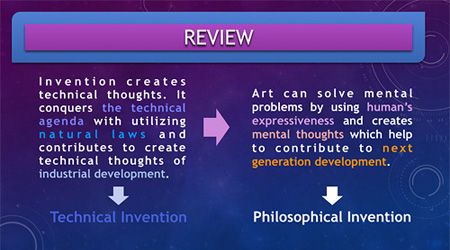
In conclusion, I organized my thinking of the relationship with the technical invention and my art. Invention creates technical thoughts . It conquers the technical agenda with utilizing natural laws and contributes to create technical thoughts of industrial development. Likewise art can solve mental problems by using human's expressiveness and creates mental thoughts which help to contribute to next generation development.
Thus, I say art is mental and philosophical invention.

